Automation Testing Services The Thought Frameworks Way!
Introduction
An organization’s key goal is to deliver products in an accelerated mode and this, in turn, transfers the pressure to the Development team. With no compromise on the quality of the software, the Quality Assurance team’s goto will be Functional Automation Test Service Methodology to keep up with the pace and requirement and also ensuring quality and reliability of the web applications intent to deliver expected results.
Definition
Functional Automation testing services is the process through which the Quality Assurance Team determines if a piece of software is performing as per the predetermined requirements by employing automated testing tools.
Significance
Automation Testing Services Bug Hunt Process
Thought Frameworks is a tool-agnostic Organization. Our QA team - The Thoughframeworkers provides ideal solutions for common, repetitive, and high-volume testing by coordinating, managing, and sharing results from a centralized location.
Thought Frameworks QA Automation team provides the ideal solution for common, repetitive, and high-volume testing by coordinating, managing, and sharing results from a single, centralized location by using automation tools (both open source and commercial) to provide end-to-end automation services and a reporting engine by defining, building an enterprise automation framework.
Methodology
Automation Testing Services Bug Hunt Process
One of the best ways to improve a software’s efficiency, performance, and test coverage by Automated Testing. It also eliminated the manual requirements in the testing cycle.
Thought Frameworks Automation Test Culture (TF-ATC):
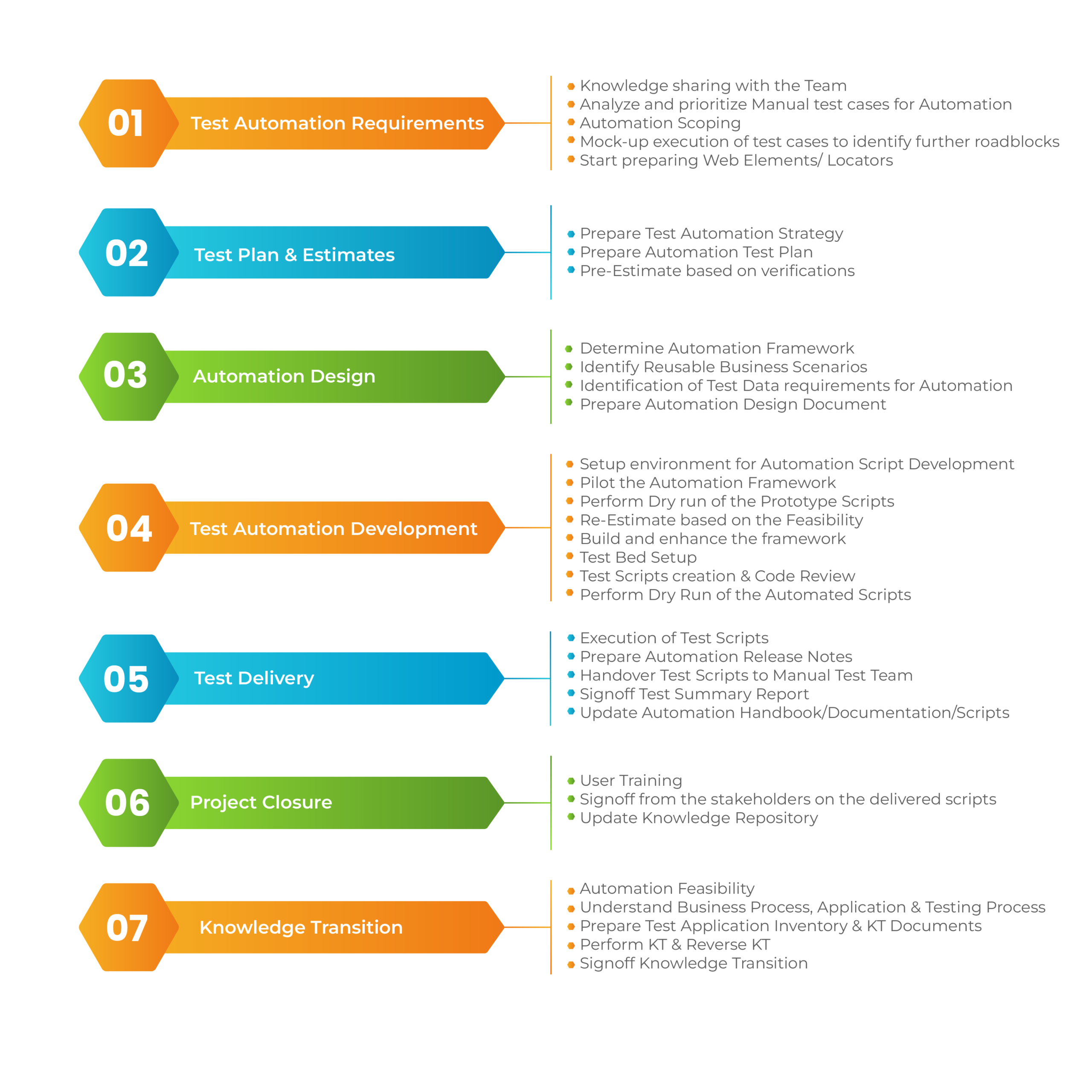
Thought Frameworks Automation Test Culture
- Knowledge Transition:
- Automation Feasibility
- Understand Business Process, Application & Testing Process
- Prepare Test Application Inventory & Knowledge Transition Documents
- Perform KT & Reverse KT
- Signoff Knowledge Transition.
- Test Automation Requirements:
- Knowledge sharing with the Team
- Analyze and prioritize Manual test cases for Automation
- Automation Scoping
- Mock-up execution of test cases to Identify further roadblocks
- Start preparing Web Elements/Locators.
- Test Plan & Estimates:
- Prepare Test Automation Strategy
- Prepare Automation Test Plan
- Pre-Estimate based on verifications.
- Automation Design:
- Determine Automation Framework
- Identify Reusable Business Scenarios
- Identification of Test Data Requirements for Automation
- Prepare Automation Design Document.
- Test Automation Development:
- Setup Environment for Automation Script Development
- Pilot the Automation Framework
- Perform Dry run of the Prototype Scripts
- Re-Estimate based on Feasibility
- Build & Enhance the Framework
- Test Bed Setup
- Test Script Creation & Code Review
- Perform Dry Run of the Automated Scripts.
- Test Delivery
- Execution Test Scripts
- Prepare Automation Release Notes
- Handover Test Scripts to Manual Test Team
- Signoff Test Summary Report
- Update Automation Handbook/Documentation/Scripts.
- Project Closure
- User Training
- Signoff from the Stakeholders on the delivered Scripts
- Update Knowledge Repository
The Importance of Functional Automation Testing
Automated Testing is required for the following reasons:
- To Simplifying Test Execution
- To increase the speed with which tests are executed (test scripts)
- To Increase the amount of Test Coverage
- To Increase the Test’s Reliability
- To shorten the development cycles
- To minimize the human interaction with testing
- To lower the cost of test maintenance
- To improve the accuracy of software tests
- To save time & money
- To improve team morale.
- To get rid of tedious activities
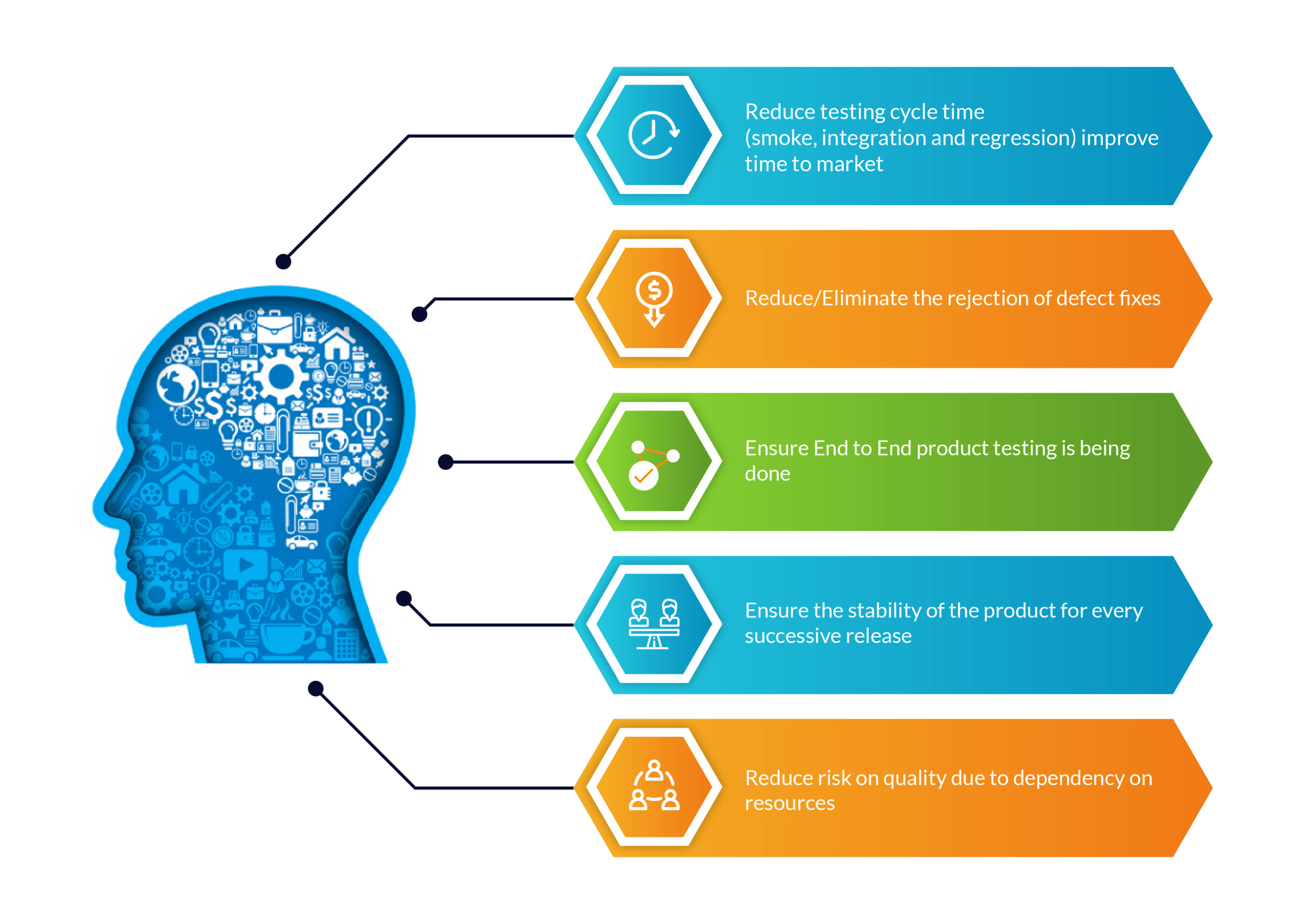
Compatibility
Tests feasible for Automation Testing Service
Section 2.1 (Tests feasible for Automation)
Unit Testing: Unit testing is the process of isolating and testing a single unit of an application from the rest of the software. Unit testing is done during the development phase and it is the first level of testing.
Integration Testing: The primary goal of integration testing is to validate how modules communicate and interact with one another, as well as to assess a system's compliance.
Regression Testing: Regression suites are growing in size, and the same variables must be filled multiple times to ensure that new features do not interfere with older functions. This is easily automated.
Testing of complex functionalities: All tests that require complex computations are prone to human errors, hence it should be automated.
Smoke Testing: Using automated suites to ensure delivery of high quality functionalities. It also gives a pulse check of whether a build requires more extensive testing.
Data-driven Testing: This testing is employed whenever there is a large amount of datasets that require repeated testing as the build progresses.
Performance Testing: As it would be exceedingly tedious and time-consuming to track the performance of software under various conditions automation testing is deployed.
Functional Testing: Functional testing must be performed rapidly and offer timely feedback whenever a developer submits a pull-request(PR). This is impossible to execute without automation, particularly as the business grows.
Suitable Test Cases for Automation
- High Risk - Business Critical Scenarios
- Test Cases that are repeatedly executed
- Test Cases that are very tedious or difficult to perform manually
- Test Cases that are time-consuming
Non suitable Test Cases for Automation
- Test Cases that are newly designed and not executed manually at least once
- Test Cases for the requirements are frequently changing
- Test Cases that are executed on an ad-hoc basis
What happens when you don't do Functional Automation Testing?
- Defects resolution takes time
- Scope of defect identification is decreased
- Full Test Coverage may not be possible
- No clarity on product deadline
- Increases the cost of the project
- Increases resource effort for the project
- Reduces overall project quality.
Role of Functional Automation Testing in Agile
Agile methods rely on the efficiency and reliability of test automation in the Software Development Life Cycle. Agile emphasizes the significance of test automation Continuous Integration (CI), Continuous Delivery (CD), Test-Driven Development (TDD), and Behaviour-Driven Development (BDD). Strong test automation procedures also highlight the culture change and value of teamwork that Agile brings.
Thoughtframeworks Functional Web Automation Approach
Thoughtframeworks' approach enhances the software quality and shortens development life cycle. Our skilled and dedicated resources design and develop automation frameworks. Automation tools are aligned with the testing goals. The Automation frameworks we build form a solid foundation in combination with specific automation tools to achieve accelerated project goals.
Our Experts then integrate the framework and tools by applying the best practices and coding standards to test the software which ensures ease of software maintenance.
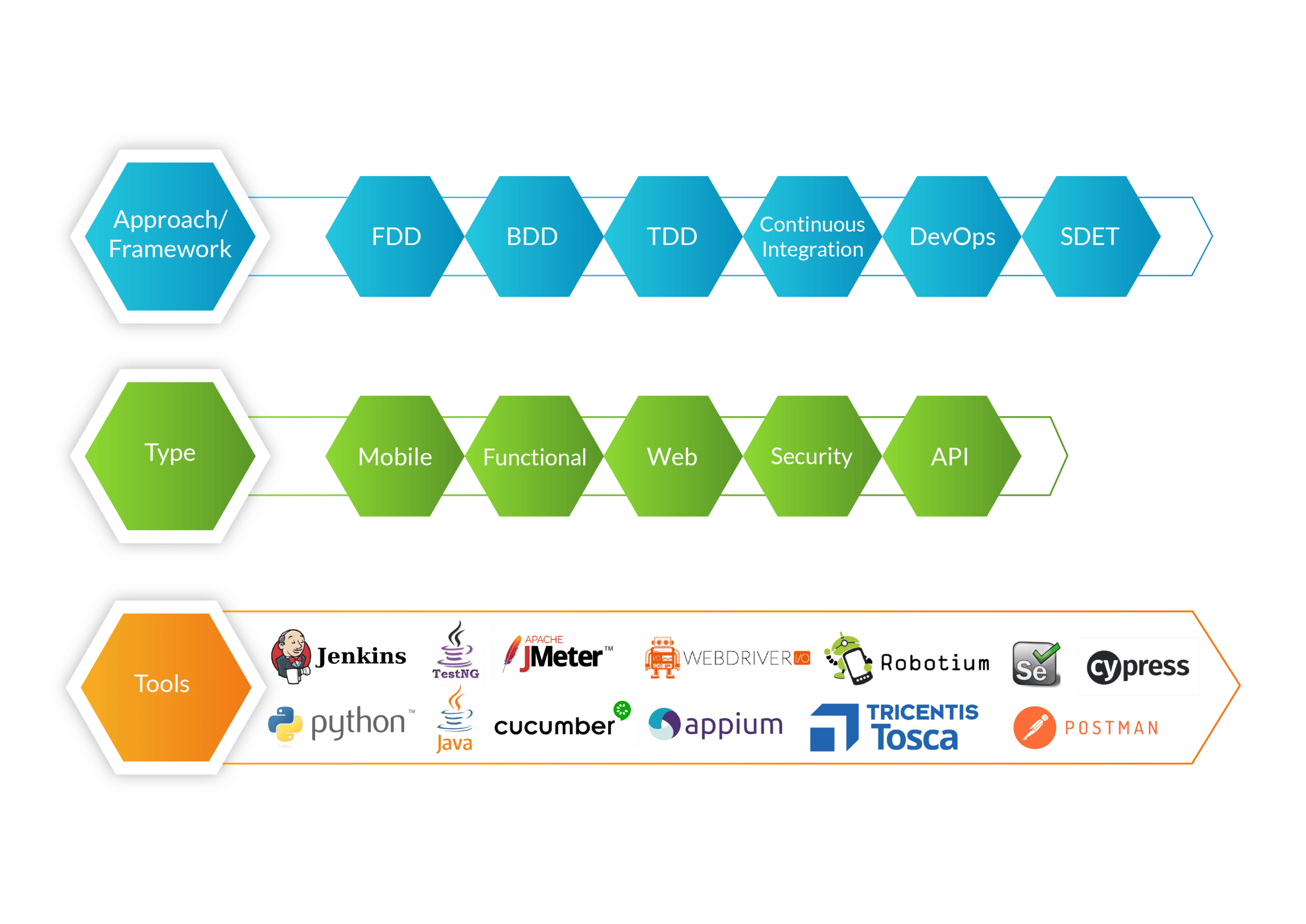
Thought Frameworks Automation Testing Approach
Types of Automation Frameworks
- Linear Scripting Framework: Test scripts are recorded and replayed in a sequential (“linear”) form with little or no changes.
- Data-driven Framework: The test scripts to run are determined by a consistent source of test data (internal or external data).
- Keyword-driven Framework: Tables on a spreadsheet define the behaviour of a test script based on a library of functions assigned for a given keyword.
- Modular Testing Framework: Individual test scripts are used to test individual modules of an application under test, which can then be combined to form larger test scripts.
- Hybrid Testing Framework: A combination of two or more frameworks to leverage the strengths of each other.
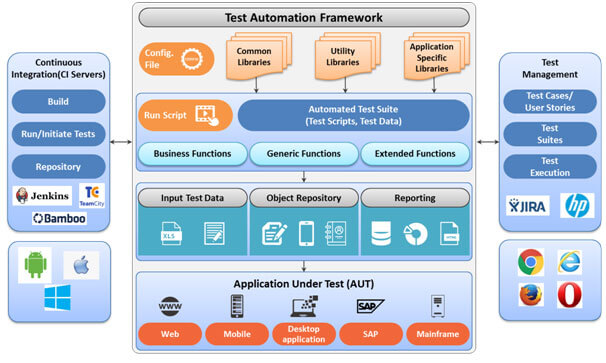
TF- Automation Framework
A poorly designed framework causes problems even if you are using the right automation software tools.
Poor planning in creating and selecting appropriate frameworks will limit the benefits of automation tests.
Our Approach
Thoughtframeworks Functional Web Automation Approach
Thoughtframeworks' approach enhances the software quality and shortens development life cycle. Our skilled and dedicated resources design and develop automation frameworks. Automation tools are aligned with the testing goals. The Automation frameworks we build form a solid foundation in combination with specific automation tools to achieve accelerated project goals.
Our Experts then integrate the framework and tools by applying the best practices and coding standards to test the software which ensures ease of software maintenance.
 Thought Frameworks Automation Testing Approach
Thought Frameworks Automation Testing Approach
Types of Automation Frameworks
- Linear Scripting Framework: Test scripts are recorded and replayed in a sequential (“linear”) form with little or no changes.
- Data-driven Framework: The test scripts to run are determined by a consistent source of test data (internal or external data).
- Keyword-driven Framework: Tables on a spreadsheet define the behaviour of a test script based on a library of functions assigned for a given keyword.
- Modular Testing Framework: Individual test scripts are used to test individual modules of an application under test, which can then be combined to form larger test scripts.
- Hybrid Testing Framework: A combination of two or more frameworks to leverage the strengths of each other.
 TF- Automation Framework
TF- Automation Framework
A poorly designed framework causes problems even if you are using the right automation software tools.
Poor planning in creating and selecting appropriate frameworks will limit the benefits of automation tests.
A standard testing procedure for mobile applications specifically designed for handheld devices is called mobile app testing. It is predominantly done to understand user engagement while parallelly checking the app's quality. The mobile app typically has three software types: native applications, mobile web apps, and hybrid applications. Why Mobile App Automation Testing is important The ability to automate mobile app testing is critical as it allows faster testing and extends its scope of coverage across platforms and test scenarios. When performed incorrectly, automation can be flaky and time-consuming, making it incompatible for the effort required to set up. The key benefits of strategic implementation:- More Rapid Feedback
- Faster bug detection
- Enhanced risk mitigation
- Increased test coverage
- Shorter time to release.
- Functional Testing: Used often for testing UI elements, modification of screens, fundamental structures, and app functionality. Also checks installation and update processes, location settings, compatibility, and accessibility of Application Under Test (AUT).
- Interrupt Testing: Interrupt testing is an automation testing procedure that determines the ability of an app to operate further during the simultaneous operation of an application. For example, when a call or message is received, how the application reacts. Some applications do not work as it should be minimized once, or when another app receives or sends a notification that overshadows it temporarily.
- Regression Testing: Checks to see if the most recent updates or patches have introduced any new regressions or issues in the mobile app system. It is done on a regular basis to ensure that new modifications are feature enhancements rather than bugs in the application.
- Set out a clear mobile testing strategy and define objectives before performing the actual tests.
- Perform UI testing on actual mobile devices rather than emulators or simulators.
- Ensure that tests are used in the initial phase as well as gradually throughout the development process.
- Prioritize testing on specific devices and operating systems, as testing on all devices, operating systems, and network combinations are impracticable.
- Adequate performance, stress, and security testing are performed
- Take the appropriate tests to cover app interoperability, battery usage, and fault tolerance.
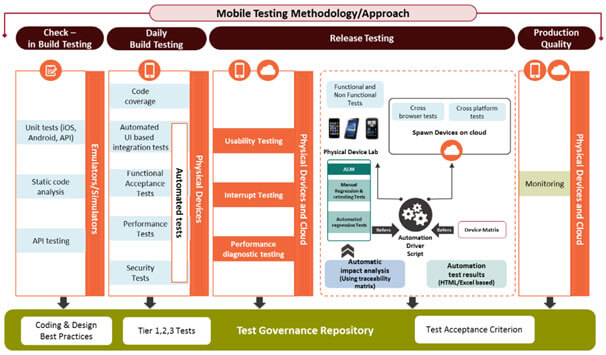
Thought Frameworks Mobile Application Testing Approach
Tools
Functional Automation Testing Tools
- Tricentis TOSCA
- Postman
- Apache JMeter
- SoapUI
- Selenium
- WebdriverI/O
- Appium
- Selendroid
- Espresso
- XCUITest
- MonkeyRunner
- Jenkins
- Bamboo
- JIRA
The Thoughframeworkers and their experience in Functional Automation Testing
Adding value to Functional Automation Testing requirements:

Increase the number of development cycles

Achieve Resilience and ease of execution

Greater Scalability
